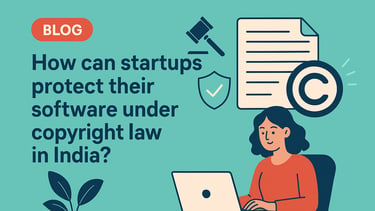How can startups protect their software under copyright law in India?
Abstract Copyright law is critical to the preservation of intellectual property rights, particularly for startups. Brand law is to allow generators exclusive rights to reproduce, distribute, and parade their workshop.
IPR
Tanu Jamwal
7/23/20253 min read


In today’s fast-moving digital world, software plays a big role in how we live and work every day. Whether it's shopping, learning, or running a business—software is everywhere. That’s why it’s really important to protect new software ideas. Startups, especially, need strong legal protection to stay ahead and keep their innovations safe from being copied.
The Indian legal framework establishes detailed software protection measures that maintain an equilibrium between authorship rights and corporate needs and public access. The complete knowledge of this legal framework stands essential for software developers and organizations who aim to maintain lawful protection of their products.
The Indian Copyright Act of 1957 identifies software as a form of literary work under its legal provisions. A creator of original software automatically receives copyright ownership over their work. The absence of official copyright registration makes it difficult to establish ownership when others duplicate or misuse the code. Registering the software provides additional protection and serves as concrete evidence of ownership.
How to register a software under copyright in India
The process to register your software copyright in India remains simple yet requires precise execution of all steps to achieve legal protection.
You must first complete the copyright registration form available on the Indian Patent Office website. The form requires essential information about your software, including its title, together with the developer name and development date.
Your software source code requires preparation before you can submit it for registration. The code must be converted to a PDF format as part of the submission process. You should submit your entire source code if it contains no more than 20 pages, but submit only the first 10 pages if your code exceeds this length.
The source code must be uploaded together with the completed form. Original work receives copyright protection, so you should submit evidence of your authorship, such as design documents or development logs, along with your submission.
You will have to make the payment of ₹500 as the registration fee after everything is ready.
The application will go through a review process at the copyright office to verify all the information is correct. Your submission might face rejection if it contains any missing information or incorrect details. Your claim can face objections from others during a 30-day period that starts after submission. The software will receive official registration once the process confirms there are no problems with your application.
Your work will receive Indian copyright protection for 60 years after publication once it gains official registration under Indian law. The code remains protected under law during this time period against unauthorized copying or selling or usage by others. The protection period ends, after which the work enters public domain status.
Fair Use Doctrine under copyright law
The fair use doctrine specified in sec. 52 of the Copyright Act functions as an important part of copyright law, which permits restricted usage of copyrighted content without obtaining permission from the copyright holder, especially for purposes of criticism, commentary, research, and education.
Startups can benefit from this since it enables them to utilise content creatively in their brand and product development, yet they must be mindful of potential copyright violations.
The court in Chancellor Masters v. Delhi High Court (2008) established that fair use or fair dealing exists as a fundamental component of copyright law.
In conclusion, copyright law functions as a crucial tool for businesses that seek to defend their software code. Software code represents the core element of modern digital systems, while organisations dedicate substantial funds to its development, so they establish legal protection through copyright legislation.
Copyright protection extends only to original expressions rather than abstract concepts. The act of copying your code violates copyright protection even if the person who copied it created the same program. Understanding which types of code qualify for copyright protection, along with those that do not, makes software protection more manageable while supporting technological development.
